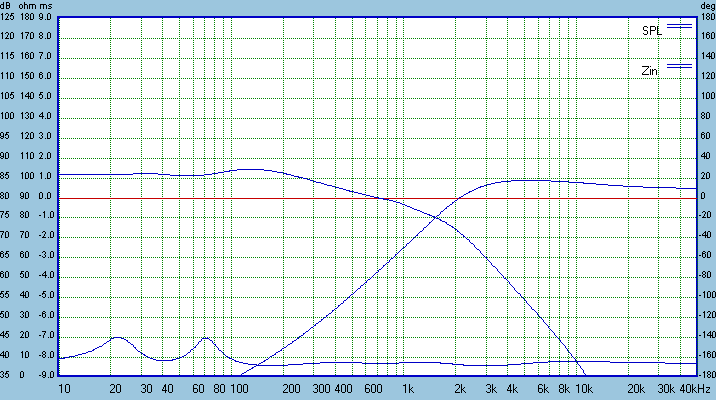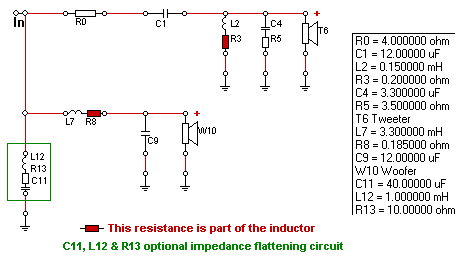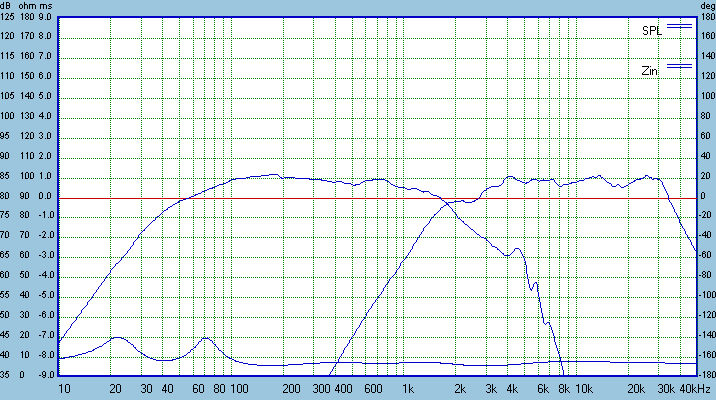Hi, this is my first post. I have been looking for a simple LR2 3 way crossover single supply schematic. I can regulate the voltage between 11- 30vdc. I don't need a buffer on the input/output. I can use mono or dual op amps. I have made a few dual supply crossovers but not sure how to wire or calculate frequencies for single supply. Any help would be appreciated. I'm planning on cross over points @ 3k and 80hz.... mid would see 80hz to 3k. I prefer Linkwitz Riley 12db, that way if I need to I can add a second 12db to make 24 db slope. Any help would be appreciated.
Welcome to diyAudio 
If you can wade through this thread then you should see how to connect up a single supply version of an opamp based filter. Have a look at posts around #200
http://www.diyaudio.com/forums/analog-line-level/248946-designing-noob-preamp-single-supply.html
If you can wade through this thread then you should see how to connect up a single supply version of an opamp based filter. Have a look at posts around #200
http://www.diyaudio.com/forums/analog-line-level/248946-designing-noob-preamp-single-supply.html
Hi,
Because crossovers are far more complicated than you think.
Baffle diffraction and driver responses have to be considered.
For Zaph|Audio - ZA-SR71

Is the electrical transfer function and the result is LR4 at 1.75KHz acoustic.
The x/o itself is 2nd order electrical :

rgds, sreten.

Assymetry of the x/o is used to control vertical directivity.
Because crossovers are far more complicated than you think.
Baffle diffraction and driver responses have to be considered.
For Zaph|Audio - ZA-SR71

Is the electrical transfer function and the result is LR4 at 1.75KHz acoustic.
The x/o itself is 2nd order electrical :

rgds, sreten.

Assymetry of the x/o is used to control vertical directivity.
Last edited:
I'll ask again, what would not work well? What are you referring to that would not work well, the active part or the design that Mooly and Buehgemeiste came up with? I'm talking active filters, I like the Linkwitz–Riley because of the simple phase changes and no bump at the crossover frequency. I also like that I can use similar part values. I like simple and minimal components in the signal path. I am not an engineer, just looking for a design that meets my criteria and that I can calculate new values for my crossover points.
Steven
Steven
I'm confused about what you are referring to as driver response. I'm keeping the drivers in their happy frequency ranges so they don't beam or bottom out. Also the off axis is quite good for the frequencies I have chosen. I don't need any notch filters or anything passive. The amplifiers only play the frequencies that the crossover sends them. I have done side by side comparison with passive crossovers VS active with equally good filtering components and the active is way better all around. I don't want to debate passive VS active, I personally like active and that is what I am building. I just don't know the lay out of the components for a single supply to avoid noise, oscillation or damage to the IC's.
Mooly, the link you posted, is that a variation of a butterworth? I'm not an EE please forgive me.
Mooly, the link you posted, is that a variation of a butterworth? I'm not an EE please forgive me.
hi SLMartain,
I now use adjustable active crossovers for the very reason these guys are saying,to make it simple,you can measure all speakers parameters and build the correct box,but until you put sound into it the box,Then you will be able to read what freqency it will actually produces and at what levels,
I use a DCX 2496 and a Deq 2496 with a mike into a real time analizer to see what the speaker and box are putting out, there are several programs like REW to help you make these readings and adjust your internal of the speaker box to produce the desired freqency output or the range of that box.So build it and test it then you can say it's right on and should reproduce all freqencies to produce music,I hope this is a good understandable explanation.
On ESP's website he has some very good tutorials on passive and active crossovers and how to build them! good luck to you!
Have FUN,
NS
I now use adjustable active crossovers for the very reason these guys are saying,to make it simple,you can measure all speakers parameters and build the correct box,but until you put sound into it the box,Then you will be able to read what freqency it will actually produces and at what levels,
I use a DCX 2496 and a Deq 2496 with a mike into a real time analizer to see what the speaker and box are putting out, there are several programs like REW to help you make these readings and adjust your internal of the speaker box to produce the desired freqency output or the range of that box.So build it and test it then you can say it's right on and should reproduce all freqencies to produce music,I hope this is a good understandable explanation.
On ESP's website he has some very good tutorials on passive and active crossovers and how to build them! good luck to you!
Have FUN,
NS
Last edited:
I'm confused about what you are referring to as driver response. I'm keeping the drivers in their happy frequency ranges so they don't beam or bottom out. Also the off axis is quite good for the frequencies I have chosen. I don't need any notch filters or anything passive. The amplifiers only play the frequencies that the crossover sends them. I have done side by side comparison with passive crossovers VS active with equally good filtering components and the active is way better all around. I don't want to debate passive VS active, I personally like active and that is what I am building. I just don't know the lay out of the components for a single supply to avoid noise, oscillation or damage to the IC's.
Mooly, the link you posted, is that a variation of a butterworth? I'm not an EE please forgive me.
The frequency AND phase response of the drivers must be accounted for by the crossover or the final acoustic output won't be what is assumed. A driver on an open baffle, infinite baffle or closed box will exhibit a second order response that must be included in the total crossover design, this applies to both passive and active crossovers. Mr. Linkwitz has a pretty good write up covering that here: Crossovers
Mike
Last edited:
Guys, crossovers are not new to me, only the electrical designs is where I struggle. I have built several active speakers over the years with great success. I use to work at a very high end stereo shop where I could compare my designs to the $100k speakers. I have even made a pair of Wilson audio Alexandria X2's active for a customer, it was quite the improvement. I don't have all the measuring equipment now because I changed careers, but I can still get amazing results with my own ears. After all, if my own stereo sounds good to me that's all that matters to me. I normally copy and adapt the basic LR2 from Likwitz's web site. I don't know how the electrical components work in the crossover but I know how to change the caps and resistors for the frequencies I want.
So can some one post a basic LR2 single supply schematic.
So can some one post a basic LR2 single supply schematic.
- Status
- This old topic is closed. If you want to reopen this topic, contact a moderator using the "Report Post" button.
- Home
- Source & Line
- Analog Line Level
- single supply Linkwitz Riley 3 way crossover